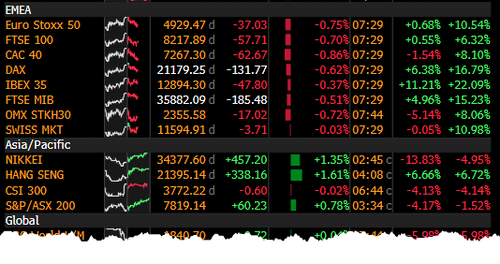The global crypto market is facing another major downturn, with widespread sell-offs across nearly every digital asset. Prices of leading cryptocurrencies have plunged, investor sentiment has turned sour, and trading volumes have spiked due to panic-driven activity. This sharp decline is not isolated—it reflects broader economic pressures, geopolitical tensions, and market-specific risks that are collectively dragging the market into a red zone.
Current Market Snapshot As of April 8, 2025, leading cryptocurrencies show significant losses over the past 24–48 hours: Bitcoin (BTC) : Trading at approximately $78,916, down 3.48% from the previous close. The price fluctuated between a low of $75,773 and a high of $80,936 during intraday trading.

Ethereum (ETH) : Valued around $1,566.65, marking a 4.99% decline.
Intraday lows reached $1,477, indicating heavy selling pressure in the market. Binance Coin (BNB): Standing at $557.15 after a 3.
08% fall, with prices ranging between $538 and $570 during the session. XRP (XRP): Trading at $1.87 after a 6.
25% drop, with the token slipping to $1.75 at its lowest point in the session. Cardano (ADA) : Currently priced at $0.
581, down 6.83%, having dropped as low as $0.537.
These figures reflect a broader trend of investor retreat from digital assets as risk aversion intensifies globally. Key Reasons Behind the Market Downturn The recent introduction of new 10% tariffs on global imports by the U.S.
administration has created fresh panic across global markets. This economic policy move has sparked fears of a full-blown trade war, especially as affected countries prepare for potential retaliation. The result: investors are rapidly exiting riskier assets like cryptocurrencies, shifting capital toward safer options such as government bonds and gold.
Asian and European markets opened significantly lower following the announcement, and crypto markets followed suit. Bitcoin and Ethereum dropped quickly as soon as the Asian trading session began, revealing just how interconnected the crypto ecosystem has become with the broader financial environment. While cryptocurrencies have long been considered an alternative investment class, they are now exhibiting increased correlation with traditional financial markets.
As global stock indices drop—particularly in tech-heavy sectors—cryptocurrencies also fall. The parallel sell-off across equities and digital assets demonstrates that when global economic pressure mounts, traders liquidate both stocks and crypto holdings to preserve cash and reduce risk exposure. During periods of heightened market fear, traders are more likely to liquidate highly volatile assets first.
Bitcoin, despite its long-term value proposition, still falls into this category during short-term shocks. From a technical perspective, Bitcoin and other major cryptocurrencies broke through key support levels over the past few days. Bitcoin recently fell to $74,436, a level not seen since November of last year.
Analysts warned that a failure to hold support near $73,745 could open the door for a deeper correction toward the $55,000–$57,000 range. Technical patterns like the “death cross” — where the 50-day moving average crosses below the 200-day moving average — suggest strong bearish momentum in the market. The break below the psychological $75,000 mark further intensified selling, as traders expected more downside in the absence of bullish catalysts.
Ethereum mirrored this weakness , falling below critical levels and showing no immediate signs of strong institutional support. The total market capitalization of all cryptocurrencies dropped below $2.5 trillion, signaling the scale of the ongoing correction.
Regulatory uncertainty continues to cast a long shadow over the cryptocurrency industry. Authorities in major economies, including the U.S.
and the European Union, have hinted at stricter regulations, especially targeting centralized exchanges, stablecoins, and cross-border digital asset flows. The lack of a unified global regulatory framework adds to market confusion. Traders remain unsure whether forthcoming policies will encourage innovation or stifle it.
Until greater clarity emerges, market participants are likely to remain on edge, interpreting any official statement or action as a potential risk to crypto operations and valuations. High leverage remains a critical vulnerability in the crypto market. As prices dropped sharply, thousands of over-leveraged long positions were liquidated.
Within just 24 hours, over $840 million in long positions vanished from major exchanges. These cascading liquidations pushed prices down even further, creating a snowball effect. Leverage amplifies both gains and losses, and in this case, it intensified the panic.
Retail investors and high-frequency traders faced margin calls, and in many cases, exchanges automatically sold their holdings to cover losses. The result: deep intraday dips across nearly every major token. Impact on Crypto-Linked Companies The ripple effect of declining cryptocurrency prices extends beyond digital assets themselves.
Several public companies with high exposure to cryptocurrencies have also reported setbacks: MicroStrategy , a major corporate Bitcoin holder, issued a warning of a significant first-quarter loss. The company’s unrealized loss from Bitcoin holdings now stands at approximately $5.91 billion.
Its stock plunged over 10% in a single session. Coinbase and Robinhood , two leading platforms for retail crypto trading, reported lower transaction volumes amid the downturn. Their share prices fell by 6% and 4% respectively.
Analysts also downgraded their outlooks for these platforms, citing lower user engagement and reduced trading fees. These declines illustrate how deeply crypto price action affects broader business sectors, especially companies directly tied to blockchain and digital finance. Broader Economic Concerns and Market Sentiment Market sentiment has taken a definitive turn for the worse.
The Crypto Fear & Greed Index now sits deep in “Extreme Fear” territory, reflecting investor anxiety. Meanwhile, the Volatility Index (VIX), often called the “fear gauge” of the market, has risen to multi-month highs, signaling broader risk aversion. With global markets anticipating a slowdown and possibly even a recession, appetite for speculative assets like cryptocurrencies has fallen sharply.
Economic forecasts remain grim, and several analysts have warned of an “economic nuclear winter” if trade tensions escalate further. What Lies Ahead? The short-term outlook for the cryptocurrency market remains highly uncertain. Several critical factors will shape the path forward: Trade policy outcomes: Any resolution or escalation in tariff-based disputes could directly influence crypto sentiment and global risk appetite.
Regulatory updates: Clearer guidelines from major financial authorities could either stabilize the market or cause further disruptions, depending on their tone and scope. Technical recovery: Bulls must regain control of key support zones to restore confidence. Bitcoin needs to reclaim levels above $81,000 and Ethereum must hold above $1,600 to suggest a shift in momentum.
Macroeconomic trends: Inflation data, central bank policies, and GDP growth figures will continue to impact all markets, including digital assets. The cryptocurrency market has entered a critical phase, shaped by external economic shocks, internal technical breakdowns, and heightened regulatory uncertainty. The red tide across digital assets reflects a combination of fear, structural weaknesses, and global policy shifts.
While long-term confidence in blockchain technology remains strong, the immediate environment calls for caution, discipline, and close attention to both market charts and global headlines..
















